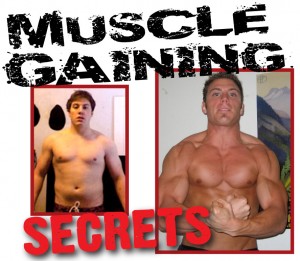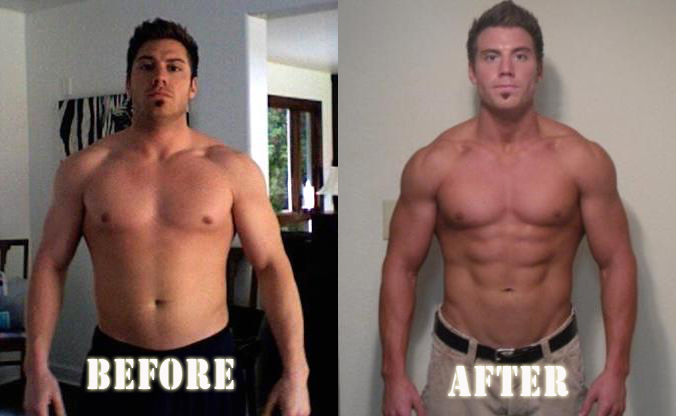 Kyle Matthews knows a thing or two about hard work and dedication. He won the first ever Muscle Gaining Secrets transformation contest a few years back, then repeated his performance when we had another transformation contest for members of the Renegade Inner Circle last year.
Kyle Matthews knows a thing or two about hard work and dedication. He won the first ever Muscle Gaining Secrets transformation contest a few years back, then repeated his performance when we had another transformation contest for members of the Renegade Inner Circle last year.
To do that twice is pretty impressive.
Especially considering the fact that between the two contests he suffered three freak injuries that set him back considerably (all of which we didn’t have the time to cover in this interview). Today Kyle’s going to share some of his experiences and explain how he trains and stays dedicated to making such dramatic improvements on a regular basis.
JF: Kyle, you and I have discussed how our training backgrounds were similar and that we made a lot of the same mistakes at the beginning. What was it that finally opened your eyes and got you on the right track? What were the major changes that helped you start making such incredible progress?
KM: You were what finally opened my eyes.
I had tried TONS of different programs with the same dedication I have now. I never got results, so I moved onto the next program I could find. I kept reading, and reading, and reading, until I finally stumbled on your Muscle Gaining Secrets program.
I sat in my bed for the rest of the day and read the ebook. I started the program the next day, and it was go-time right from the beginning.
Within the first couple weeks I was seeing unreal results. The major differences that stick out in my mind are the concept of progressive overload and the value of big, multi-joint movements.
Additionally, you taught me how to manipulate my calories depending on my goals and more importantly, how and when to manipulate my carbohydrates. Once I started experimenting with the principles, getting lean, something that I had unsuccessfully tried to do for about 7 years, became a simple matter of putting knowledge into action.
JF: What a lot of people may not know is that after the first time you transformed your physique for the Muscle Gaining Secrets 12 week contest you suffered a pretty serious injury that set you back for a while.
Can you talk about that and what you had to deal, how you trained during the injury and what you did to come back?
KM: Training was progressing well until October of 2008, when I dislocated my left kneecap. I had done this a bunch of times prior to the incident and had already had 2 knee surgeries under my belt. This time, however, it was a lot worse than before.
I fell off a fence and my leg buckled behind me on impact. My foot was literally underneath my lower back and my quad at about a 45 degree angle in relation to my torso. I remember looking down at my knee and seeing my femur bulging out against my skin. I sat up, grabbed my left ankle, and began to move my foot clockwise.
Luckily, as I straightened out my leg, my kneecap slid back into place. I instantly knew it was bad. Real bad. I tore my ACL and MCL.
Moreover, my patellar tendon was so stretched out that not only did I need to fix the tears, but I also needed a patella relocation. My surgeon fixed the tears and moved my kneecap back into place.
Because I had dislocated my kneecap so many times, he had to loosen my patellar tendon on the outside of my knee, stretch it over my kneecap, and synch it down to the inside of my knee using steel wire to make sure it didn’t happen again. Then, he went back in later to clean out all the broken cartilage and bone from the dislocations.
The last surgery was mid March of 2009. I was on crutches for about 10 weeks. Full recovery (which for me was sprinting, squatting, and deadlifting at my previous level) was marked at 1 year. It seemed long to me but my ortho is an accomplished sports surgeon that works with various Olympic teams and the Stanford Football and Wrestling teams so I went by his timeline.
Despite being on crutches, I was back in the gym training upper body as soon as I was allowed to sweat…literally.
As soon as I got the stitches out, I was back in the gym. I was lucky enough to have an awesome training partner who was willing to hand me DB’s and rack/unrack bars for me.
I basically did curls, dips, chins, and various light presses until I got off crutches. From the date of the injury to the time I got off crutches, I had gone from about 185lbs with single digit body fat to 160lbs and soft. I was getting skinny fat in a hurry. My focus switched to knee rehab 4-5 days/week and 2-3 days/week of upper body training.
I was following a push/pull kind of split for upper body. I also started bulking immediately since I couldn’t stand being 160 lbs and weak.
Over the next 8 months (until about mid February 2010) I bulked relentlessly and gained a grand total of 58 lbs topping the charts at 218 lbs. I’m pretty sure I followed MGS during the bulk but I can’t remember for sure. What ever it was, it was definitely written by you.
JF: It was a program I helped you modify because of your injury.
KM: That’s right. I got stronger than I ever had before and met some long time strength goals.
My bench maxed out at 350 lbs, which was 65 lbs heavier than my previous max and 125 lbs heavier than my max after knee surgery. I pulled 500 lbs off the rack, set about an inch below knee height, which was also a goal of mine for about as long as I have been training seriously.
 JF: Now during this latest transformation you used the Triple Threat Muscle program. Tell us a little bit about your experience on the program and the results you achieve.
JF: Now during this latest transformation you used the Triple Threat Muscle program. Tell us a little bit about your experience on the program and the results you achieve.
KM: Triple Threat is awesome. I felt like Muscle Gaining Secrets was more geared towards acquiring raw strength, power, and size whereas Triple Threat is a little more focused on enhancing overall athletic performance while sprinkling the strength and power stuff on top.
The finishers were my favorite part. My conditioning and coordination went through the roof.
I timed my 40 yard sprint when I started the program and clocked in around 5.6-5.7 seconds. At the end, I had brought that down to 4.8. That is by no means fast, but it is a lot faster than I was when I started. I was pretty impressed with those results considering that I was in no way concentrating on getting faster.
It’s obviously partly due to dropping about 20 lbs of fat throughout the duration of the program, but I think a large part of it also has to be from the design of it. The finishers are absolutely killer.
Cutting all that fat for the first contest involved lots of steady-state cardio. This time around, the finishers alone got me pretty lean. When my fat loss slowed, I added a couple more sprinting days per week.
For the last two weeks, I did fasted cardio on a treadmill 2-3 times per week…that’s it. While I was cutting for the contest, a good friend of mine was doing Triple Threat with me. He is a professional volleyball player, and a textbook hardgainer.
When he started the program, he was 200 lbs…and 6’7” tall. He did all the finishers with me and still gained 20 lbs of lean weight. That’s pretty solid proof that the finishers don’t hinder muscle gain if you’re trying to gain weight.
This was a new experience for me because last time I cut, I wasn’t very worried about losing muscle; my main goal was fat loss. That’s because I didn’t have very much muscle in the first place.
This time around, I was worried about losing hard earned muscle so I was much more conscious of my diet and how much weight I was losing week to week. I had just come off an 8-month bulk and the last thing I wanted was to mess it up and end up losing a bunch of the muscle I gained during that time.
I’m pretty sure Triple Threat took care of me in that respect. In the end, I ended up gaining some strength, which was kind of unexpected because I was so focused on cutting fat.
JF: A lot of people reading this are going to be envious of the kind of progress you have made. I mean, let’s face it, not a lot of people have the dedication to follow a diet as strictly as you do for 12-16 weeks. How do you stay dedicated and motivated and what tips do you have for others that may help them stay on track?

KM: That is a really tough question for me to answer. I don’t think dedication is something that can be taught by a person. The way I see it, dedication is something that has to be learned by the individual through experience and drive.
From the first time I set foot in a gym when I was lifting for Pop Warner Football, I was immediately intrigued by the veteran weightlifters. I was a young, chubby, weak little kid, and these guys looked gargantuan.
It was something I admired. The big weights they were moving were impressive, their large stature commanded respect, and most of all they were all really nice to me. Even though I didn’t start training seriously for a number of years after that, it stuck with me and was always something I admired.
I stay dedicated because training is something that is really important to me, and it has been for a long time.
I make the time to train because it is probably the most motivating factor in my life.
Training has taught me dedication and that same dedication has carried over into the other aspects of my life.
I’m HUGE on goal setting; it is my major source of motivation. I am constantly setting new goals, writing them down, and setting a timeline.
When you set a timeline, you have a way to measure progress and hold yourself accountable for meeting it. If you don’t have a timeframe it becomes too easy to say, “I’ll do it tomorrow” or “I’ll start next week.” Once you take that out of the equation, you just do it. And you do it for nobody but yourself.
You do it because you will know deep down that if you don’t, you have failed and given up on yourself.
The biggest tip I would give someone is to set goals.
Set a goal, write it down, and get after it. Set some goals for a week from now, a month from now, 3 months from now, 6 months from now, and a year from now.
Dream big, it’s okay to set longer term goals that seem out of reach. You want to make yourself work hard in achieving them. Write them all down on a piece of paper and put it in your pocket. Carry it with you every day. Read it at least once a day and keep adding to it as you knock ‘em off.
That is exactly what I did when I was new to setting goals and when I get off track, I go right back to that formal goal-setting system.
The only other advice I would have is to stop making excuses.
Nobody is going to do it for you so you have to get off your ass and figure it out. It would be great if we could all have someone like you follow us around, watch what we eat, keep us motivated, and train us. That’s not the case, so get over it and do it on your own.
You will make mistakes, you might even get injured, and you probably won’t make the same progress as you would if you were being professionally monitored. But, you also will gain tons of invaluable knowledge and get all the satisfaction of knowing that you did it on your own.
JF: One of the most important lessons to learn here is that Kyle does ONE program with 100% dedication and sticks with it for 12-16 weeks.
He is not a program jumper, not constantly in search of the next best thing, not constantly second guessing and questioning.
And that is why he makes better progress than 99% off all people who will ever pick up a weight.
It’s that simple, folks.
Please leave your comments or questions for Kyle below.



